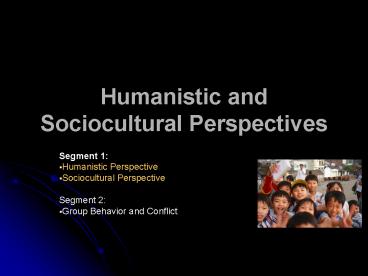Humanistic and Sociocultural Perspectives - PowerPoint PPT Presentation
1 / 17
Title:
Humanistic and Sociocultural Perspectives
Description:
Culture: Program of shared rules that govern the behavior of members of a ... Football/Basketball players after game: Winners vs. Losers ... – PowerPoint PPT presentation
Number of Views:68
Avg rating:3.0/5.0
Title: Humanistic and Sociocultural Perspectives
1
Humanistic and Sociocultural Perspectives
- Segment 1
- Humanistic Perspective
- Sociocultural Perspective
- Segment 2
- Group Behavior and Conflict
2
Humanistic
- Premise Reaction to psychoanalytic theory and
behaviorism. - Creator Abraham Maslow
- Postulates of Humanistic Psychology
- Human beings cannot be reduced to components.
- Human beings have in them a uniquely human
context. - Human consciousness includes an awareness of
oneself in the context of other people. - Human beings have choices and responsibilities.
- Human beings are intentional (Meaning/Value/Creati
vity).
3
Maslows Hierarchy of Needs
4
Social Psychology
- Culture Program of shared rules that govern the
behavior of members of a community and a set of
values/beliefs/attitudes shared by most. - Individualist Self is regarded as autonomous and
individual goals/wishes are prized above
duty/relations with others. - Collectivist Self is regarded as embedded in
relationships and harmony with ones group is
prized above individual goals/wishes. - Behavior in Social and Cultural Context
- Norm rules that regulate social life, including
explicit laws and implicit cultural conventions. - Role a given social position that is governed by
a set of norms for proper behavior.
5
Obedience Study
- Stanley Milgram (1961)
- Institutional Review Board (IRB)
- Learner and Teacher
- Holocaust
- Entrapment
- .
- __________________________________________________
______________________________________ - Factors that make people less likely to obey
- Experimenter is not in the room
- Victim was right in front of you
- Two experimenters gave conflicting demands
- Experimenter was an ordinary man (No lab coat)
- When peer group was there who refused to go
further
6
Conformity Study
- Phillip Zimbardo (1973)
- Stanford Prison Experiment
- Roles
- Why do we follow the group and fill in our roles
like this? - Why do we have less control over our behavior
than we would like to believe? - Why do we establish norms and feel uncomfortable
when they are violated?
7
Conformity StudyAbu Ghraib
- Baghdad Correctional Facility
- 2004
8
Conformity StudyEstelle High Security
9
Obedience
- Factors that cause people to obey when they
- would rather not
- Allocating responsibility to the authority
(Milgram) - Making the task routine (Duty, role, behavior,
feels normal) - Wanting to be polite (Dont want to be rude)
- Becoming entrapped
- Gradual process in which individuals escalate
their commitment to a course of action to justify
their investment of time/money /effort.
10
Social Influence on Beliefs
- Social Cognition an area in social psychology
concerned with social influences on thought,
memory, perception, and beliefs.
11
Attributions
- Attribution Theory People are motivated to
explain their own and other peoples behavior by
attributing causes of that behavior to a
situation or a disposition. - Situational Identifying the cause of an action
as something in the situation or environment. - Dispositional Identify the cause of an action as
something in the person, such as a trait or a
motive. - Fundamental Attribution Error (Explaining others
behavior) - Overestimate personality factors.
- Underestimate the influence
- of the situation.
- Waitress/waiter and road rage
12
Attributions
- Self-serving Bias Tendency, in explaining ones
own behavior, to take credit for ones good
actions and rationalize ones mistakes. - Football/Basketball players after game
- Winners vs. Losers
- Just-World Hypothesis Good things happen to good
people, bad things happen to bad people. - If something bad happens to you, you must have
deserved it.
13
Attitudes
- Familiarity effect Tendency of people to feel
more positive toward a person/item/product/ other
stimulus that they have seen before. - Validity effect Tendency of people to believe
that a statement is true or valid simply because
it has been repeated many times.
14
Forer Effect
- Also called personal validation fallacy or the
Barnum Effect. - The observation that individuals will give high
accuracy ratings to descriptions of their
personality that supposedly are tailored
specifically for them, but are in fact vague and
general enough to apply to a wide range of
people. - Provides a partial explanation for the widespread
acceptance of some beliefs and practices, such as
astrology, fortune telling, and some types of
personality tests.
15
Social Psychology
- Other-Race Effect-
- People can recognize faces of their own race
better than they can of other races.
16
Persuasion
- Key aspects of coercive persuasion
- Person is put under physical or emotional stress.
- Persons problems are reduced to one simple
explanation. (Which is repeatedly emphasized) - Leader offers unconditional love/acceptance/attent
ion. - New identity based on the group is created.
- (Part of the whole)
- Person is subjected to entrapment.
- (Start off small in demands but then they
increase) - Persons access to information is severely
controlled. - (Mainly contradictory information)
17
Prisoners Dilemma































